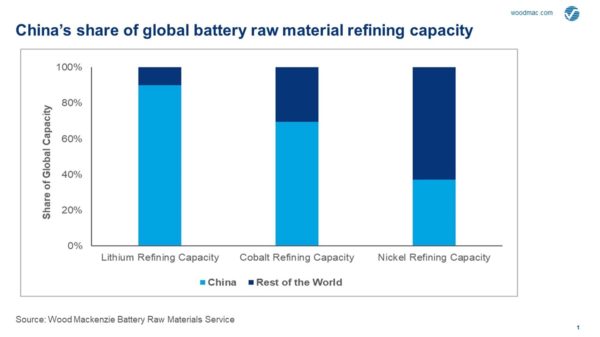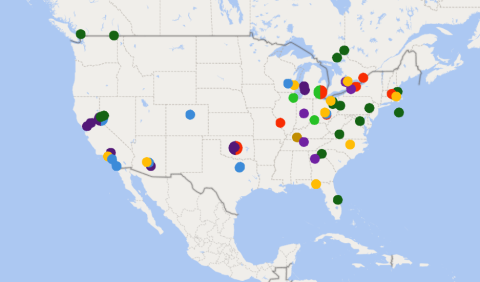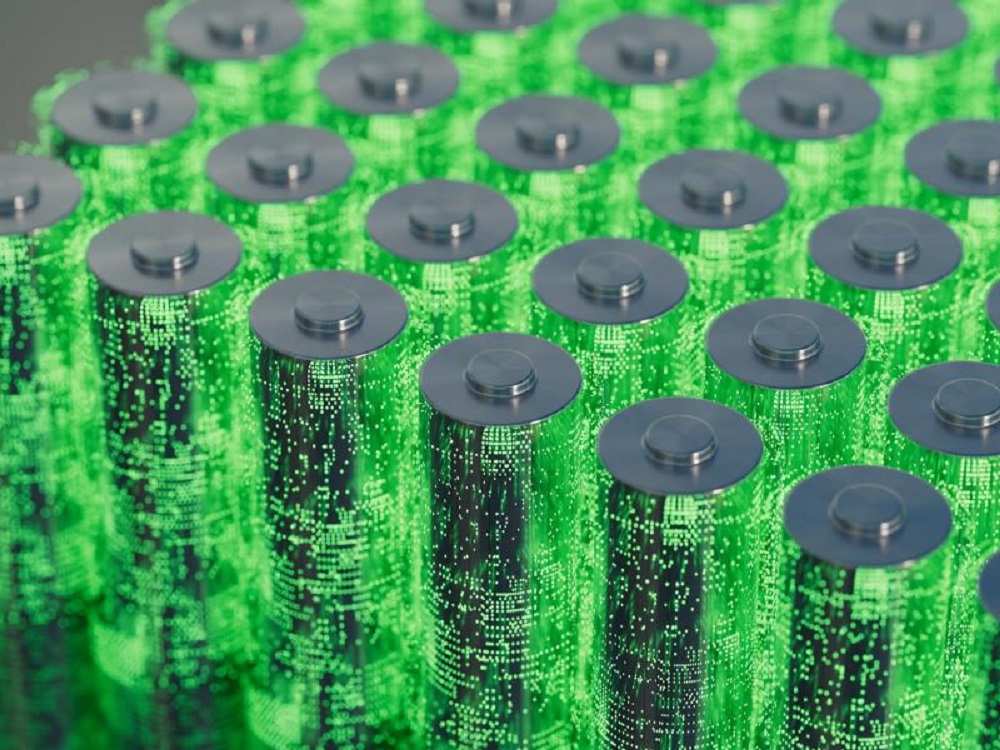The effort underway in the United States to cut carbon emissions in half by 2030 is placing increased emphasis on going “all electric”. The electrification of transportation is well underway, but is creating a huge demand for battery energy storage. With China dominating the lithium market, it’s time to shore up the domestic production of lithium.

China currently holds over 80% of the world’s lithium refining capacity, over 60% for cobalt, and more than a third of global nickel refinement, according to a report from Wood Mackenzie.
In a recent OpEd in pv magazine USA, Jose Francisco Velasco, vice president of commercialization of Mangrove Lithium, noted that with increased manufacturing of electric vehicles, demand for lithium will outstrip supply. He pointed to a report from Benchmark Mineral Intelligence that forecasts the lithium supply gap to be 725kt by 2040 in North America and Europe, or enough to hold back 350 million electric vehicles.
Last year Secretary of Energy Jennifer M. Granholm announced funding to increase lithium production, pointing to the newly published National Blueprint for Lithium Batteries 2021 to 2030 as the guiding force behind the investment. The report projects a need for a 70% rise in U.S. production of nickel by 2040; 200% for cobalt; and 600% for lithium.
The Blueprint expresses the need to strengthen U.S. competitiveness in lithium battery innovation and manufacturing with a plan for domestic supply chain development. To this end, the National Renewable Energy Lab developed the NAATBatt Lithium-Ion (li-ion) Battery Supply Chain Database, a directory of North American companies in the lithium-ion supply chain: manufacturing, research and development, services, end of life management, and product distributors.
The database is an initial step in understanding the strengths and gaps in the North American lithium-ion battery supply chain, and it will be regularly updated as the li-ion battery technology market evolves. NAATBatt and NREL are sharing this database with the public, industry, investors, and decision makers to help them better understand the status of the North American li-ion supply chain, identify strengths and gaps, promote collaboration, and identify potential investments.

Source: NREL
The collaboration between NAATBatt International and the National Renewable Energy Laboratory (NREL) intends to identify every company in North America involved in building lithium-ion batteries from mining to manufacturing to recycling. First released in September 2021 and funded by NAATBatt International, the database was recently updated and significantly expanded after extensive work by a team of NREL researchers and support from three NAATBatt committees—Manufacturing in North America, Battery Recycling, and Battery Markets.
The database lists North American companies in the li-ion supply chain, including manufacturing (raw material through battery packs), research and development, services (e.g., battery repair, consulting), recycling, and product distributors. In addition, where available, the database summarizes critical information such as installed battery manufacturing capacity (in gigawatt-hours) and material production capability (in tons per year), plans for future capacity, types of chemistries and processes, and expansion plans by sector (e.g., transportation, stationary).
“One of the early challenges we identified when assessing the strengths and gaps in the North American lithium-ion supply chain was insufficient data about domestic companies involved in every aspect of battery manufacturing,” said Ahmad Pesaran, senior energy storage researcher at NREL . “This database is an initial step in better understanding the lithium-ion battery market and its North American players.”
Researchers developed the database by exploring business directories, trade show information, market data, literature, and reports to identify existing companies within the lithium-ion supply chain. The team also performed extensive outreach through direct calls, interviews, and a questionnaire that sought clarification about facilities.
As a result, the database now identifies more than 480 companies and over 560 facilities within North America’s lithium-ion supply chain, including mining, material processing, manufacturing, research and development, services, end-of-life management, and product distributors. For each facility, the database lists key information about the company, location, workforce, and products and services. In addition, the database summarizes critical information such as installed battery manufacturing capacity and material production capability, plans for future capacity, types of chemistries and processes, and expansion plans by sector. The updated database also has advanced search and mapping capabilities to help visualize the evolving market.
“This database brings a unique value to the booming lithium-ion battery market, which is bolstered in part by growing electric vehicle sales,” Pesaran said. “We’ve already received significant interest in this database with more than 800 new downloads from users.”
NREL notes that the value and accuracy of the database will depend on new information from industry members. For inclusion in future updates, companies are encouraged to reach out to LIB.SupplyChain@nrel.gov.
This content is protected by copyright and may not be reused. If you want to cooperate with us and would like to reuse some of our content, please contact: editors@pv-magazine.com.









By submitting this form you agree to pv magazine using your data for the purposes of publishing your comment.
Your personal data will only be disclosed or otherwise transmitted to third parties for the purposes of spam filtering or if this is necessary for technical maintenance of the website. Any other transfer to third parties will not take place unless this is justified on the basis of applicable data protection regulations or if pv magazine is legally obliged to do so.
You may revoke this consent at any time with effect for the future, in which case your personal data will be deleted immediately. Otherwise, your data will be deleted if pv magazine has processed your request or the purpose of data storage is fulfilled.
Further information on data privacy can be found in our Data Protection Policy.